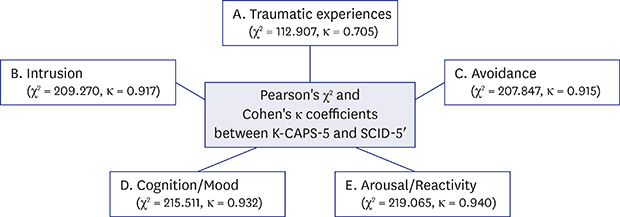1. Blake DD, Weathers FW, Nagy LM, Kaloupek DG, Gusman FD, Charney DS, et al. The development of a clinician-administered PTSD scale. J Trauma Stress. 1995; 8(1):75–90.

2. Blake DD, Weathers FW, Nagy LM, Kaloupek DG, Gusman FD, Charney DS, et al. A clinician rating scale for assessing current and lifetime PTSD: the CAPS-1. Behav Ther. 1990; 13:187–188.
3. Weathers FW, Bovin MJ, Lee DJ, Sloan DM, Schnurr PP, Kaloupek DG, et al. The Clinician-Administered PTSD Scale for DSM-5 (CAPS-5): development and initial psychometric evaluation in military veterans. Psychol Assess. 2018; 30(3):383–395.

4. American Psychiatric Association. Diagnostic and Statistical Manual of Mental Disorders (DSM-5). 5th ed. Washington, D.C.: American Psychiatric Association;2013.
5. Kulk RA, Schlenger WE, Fairbank JA, Jordan BK, Hough RL, Marmar CR, et al. Trauma and the Vietnam War Generation: Report of Findings from the National Vietnam Veterans Readjustment Study. New York, NY: Brunner/Mazel;1990.
6. van der Kolk BA, McFarlane AC, Weisaeth L. Traumatic Stress. New York, NY: The Guilford Press;1996.
7. Weathers FW, Blake DD, Schnurr PP, Kaloupek DG, Marx BP, Keane TM. The Life Events Checklist for DSM-5 (LEC-5). Updated 2013. Accessed December 15, 2017.
http://www.ptsd.va.gov.
8. Weathers FW, Ruscio AM, Keane TM. Psychometric properties of nine scoring rules for the Clinician-Administered Posttraumatic Stress Disorder Scale. Psychol Assess. 1999; 11(2):124–133.

9. Orsillo SM. Measures for acute stress disorder and posttraumatic stress disorder. In : Antony MM, Orsillo SM, editors. Practitioner's Guide to Empirically Based Measures of Anxiety. New York, NY: Kluwer Academic/Plenum;2011.
10. Lee BY, Kim Y, Yi SM, Eun HJ, Kim DI, Kim JY. A reliability and validity study of a clinician-administered PTSD scale. J Korean Neuropsychiatr Assoc. 1999; 38(3):514–522.
11. First MB, Williams JB, Karg RS, Spitzer RL. Structured Clinical Interview for DSM-5-Research Version (SCID-5 for DSM-5, Research Version; SCID-5-RV). Arlington, VA: American Psychiatric Association;2015.
12. Beck AT, Steer RA, Ball R, Ranieri W. Comparison of Beck Depression Inventories-IA and -II in psychiatric outpatients. J Pers Assess. 1996; 67(3):588–597.
13. Beck AT, Epstein N, Brown G, Steer RA. An inventory for measuring clinical anxiety: psychometric properties. J Consult Clin Psychol. 1988; 56(6):893–897.

14. Weiss DS, Marmar CR. The impact of event scale–revised. In : Wilson JP, Keane TM, editors. Assessing Psychological Trauma and PTSD. New York, NY: Guilford Press;1997.
15. Spielberger CD, Gorsuch RL. State-trait Anxiety Inventory. Palo Alto, CA: Consulting Psychologists Press;1983.
16. Rhee MK, Lee YH, Park SH, Sohn CH, Hong SK, Lee BK, et al. A standardization study of Beck depression inventory I; Korean version (K-BDI): reliability and factor analysis. Korean J Psychopathol. 1995; 4(1):77–95.
17. Cho Y, Kim EJ. Psychometric properties of the Korean version of the Anxiety Control Questionnaire. Korean J Clin Psychol. 2004; 23(2):503–518.
18. Eun HJ, Kwon TW, Lee SM, Kim TH, Cho MR, Cho SJ. A study on reliability and validity of the Korean version of Impact of Event Scale-Revised. J Korean Neuropsychiatr Assoc. 2005; 44(3):303–310.
19. Hahn DW, Lee CH, Chon KK. Korean adaptation of Spielberger's STAI (K-STAI). Korean J Health Psychol. 1996; 1(1):1–14.
20. Landis JR, Koch GG. The measurement of observer agreement for categorical data. Biometrics. 1977; 33(1):159–174.

21. Nunnally JC, Bernstein IH. Psychometric Theory. 3rd ed. New York, NY: McGraw-Hill;1994.
22. Kline P. The Handbook of Psychological Testing. 2nd ed. London: Routledge;2000.
23. DeVellis RF. Scale Development: Theory and Applications. Los Angeles, CA: Sage;2012.
24. Nunnally JC. Introduction to Psychological Measurement. New York, NY: McGraw-Hill;1978.
25. Liu P, Wang L, Cao C, Wang R, Zhang J, Zhang B, et al. The underlying dimensions of DSM-5 posttraumatic stress disorder symptoms in an epidemiological sample of Chinese earthquake survivors. J Anxiety Disord. 2014; 28(4):345–351.

26. Tsai J, Harpaz-Rotem I, Armour C, Southwick SM, Krystal JH, Pietrzak RH. Dimensional structure of DSM-5 posttraumatic stress disorder symptoms: results from the National Health and Resilience in Veterans Study. J Clin Psychiatry. 2015; 76(5):546–553.
27. Armour C, Contractor A, Shea T, Elhai JD, Pietrzak RH. Factor Structure of the PTSD Checklist for DSM-5: relationships among symptom clusters, anger, and impulsivity. J Nerv Ment Dis. 2016; 204(2):108–115.
28. Nardo D, Högberg G, Jonsson C, Jacobsson H, Hällström T, Pagani M. Neurobiology of sleep disturbances in PTSD patients and traumatized controls: MRI and SPECT findings. Front Psychiatry. 2015; 6:134.

29. Contractor AA, Durham TA, Brennan JA, Armour C, Wutrick HR, Frueh BC, et al. DSM-5 PTSD's symptom dimensions and relations with major depression's symptom dimensions in a primary care sample. Psychiatry Res. 2014; 215(1):146–153.

30. Armour C, Carragher N, Elhai JD. Assessing the fit of the Dysphoric Arousal model across two nationally representative epidemiological surveys: The Australian NSMHWB and the United States NESARC. J Anxiety Disord. 2013; 27(1):109–115.

31. Harpaz-Rotem I, Tsai J, Pietrzak RH, Hoff R. The dimensional structure of posttraumatic stress symptomatology in 323,903 U.S. veterans. J Psychiatr Res. 2014; 49:31–36.

32. Reddy MK, Anderson BJ, Liebschutz J, Stein MD. Factor structure of PTSD symptoms in opioid-dependent patients rating their overall trauma history. Drug Alcohol Depend. 2013; 132(3):597–602.

33. Wang M, Armour C, Li X, Dai X, Zhu U, Yao S. Further evidence for a five-factor model of PTSD: factorial invariance across gender in Chinese earthquake survivors. J Nerv Ment Dis. 2013; 201(2):145–152.
34. Tolin DF, Foa EB. Sex differences in trauma and posttraumatic stress disorder: a quantitative review of 25 years of research. Psychol Bull. 2006; 132(6):959–992.

35. Weathers FW, Blake DD, Krinsley KE, Haddad W, Huska JA, Keane TM. The Clinician Administered PTSD Scale (CAPS): Reliability and Construct Validity. Boston, MA: Association for the Advancement of Behavior Therapy;1992.








 PDF
PDF Citation
Citation Print
Print




 XML Download
XML Download